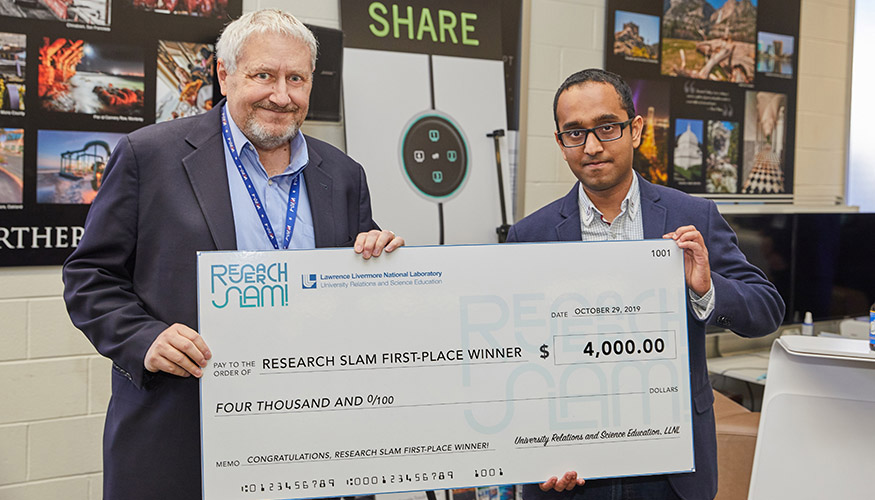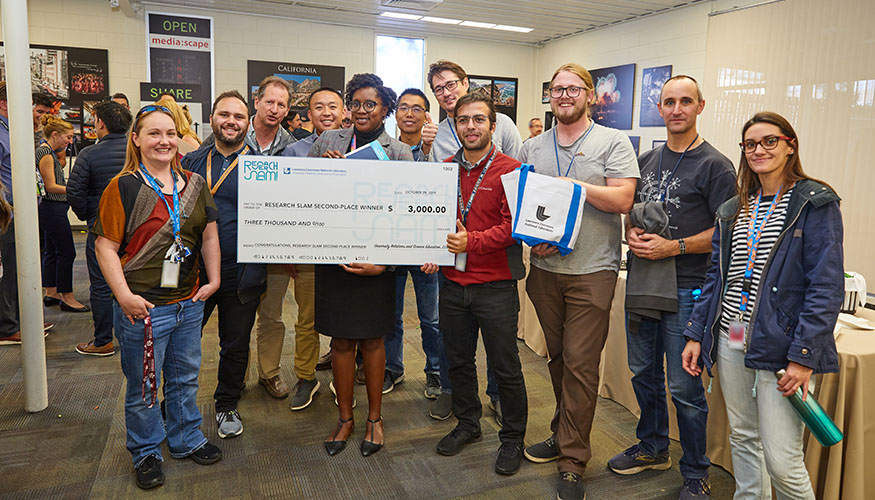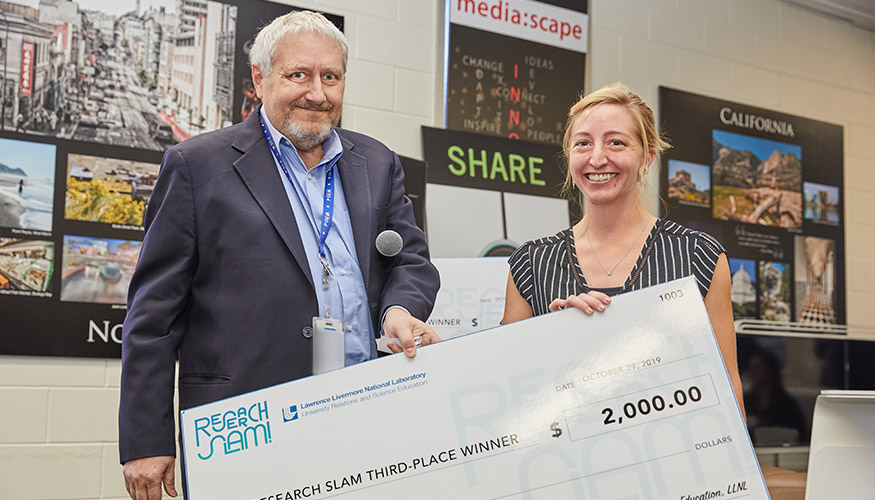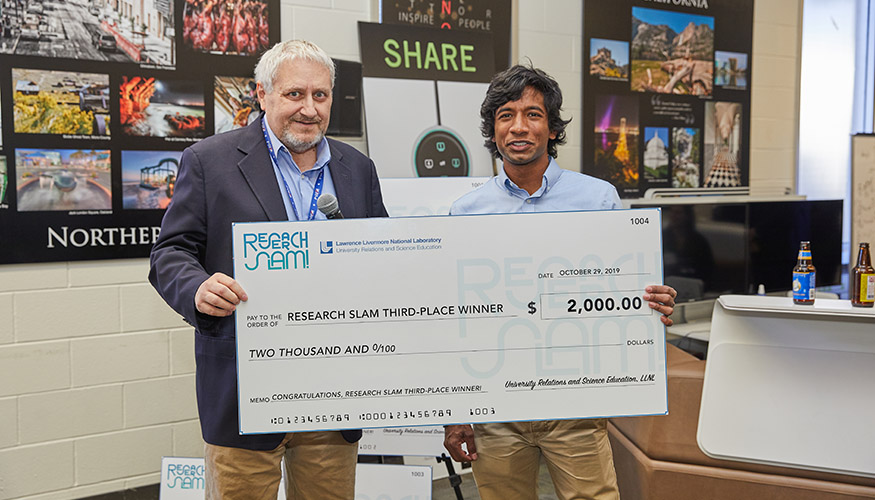PLS postdocs shine at Research Slam! competition
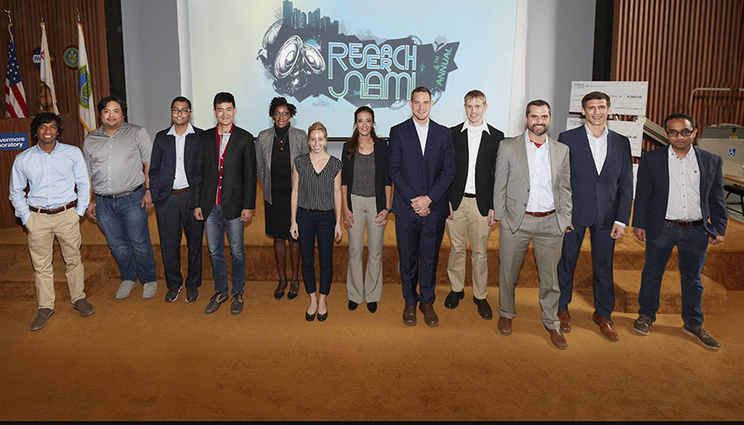 (Download Image)
(Download Image)
Twelve of the thirteen finalists selected to present at the final round of the 2019 Research Slam!
On October 29, 2019, twelve Lawrence Livermore postdocs took to the stage, each with three slides and three minutes to answer the question: “Why is your research important?”
The presentations, part of a yearly competition known as the Research Slam!, were a culmination of months of development, training, and practice. The 2019 program kicked off with seminars about developing effective presentations. Armed with information from the seminars, about 50 contestants prepared and delivered their presentations at the first round of the competition in early September, with judges ranking presenters on their ability to present the significance of their work at LLNL in a clear, direct, and interesting manner. Only 13 finalists moved on to the final round, receiving a recorded copy of their initial presentation and one-on-one coaching to perfect their presentation.
Ten of the thirteen finalists selected to present during the final event were PLS postdocs, with at least one representative from each of the five PLS divisions. Presentation topics showcased the diverse projects and research happening across PLS, ranging from identifying viruses in soils, developing self-decomposing plastic, mimicking conditions on icy moons, improving algorithms, and increasing the effectiveness of face masks that filter small particles.
The final event included an audience of Lab colleagues, family members, and a distinguished panel of judges. The judges focused on six criteria while evaluating the final presentations: intellectual significance, individual contribution to the project, clarity, delivery, visuals, and engagement.
And the winner is…
PLS postdocs swept the board at the awards reception following the event.
Thej Tumkur from the Materials Science Division (MSD) won first place for his presentation “Put a *Bessel* Ring on It: Shaping Light and the Future of Laser Materials Processing.” Tumkur featured his research into technology that shapes the beams of lasers used in metal additive manufacturing so they produce parts more rapidly and with better mechanical properties such as strength. Shaping the beam to form a ring of laser light around the central beam improves the properties of metal processed in this way.
Tomi Akindele from the Nuclear and Chemical Sciences Division won second place for her talk titled “Neutrinos for Peace,” during which she addressed her work with the WATCHMAN (WATer CHerenkov Monitor of ANtineutrinos) detector collaboration. The detector uses gadolinium-doped water to detect reactor antineutrinos from a nuclear reactor at a distance (25 kilometers). The work’s purpose is to detect, from a distance, how much plutonium a reactor is generating and whether it is legitimately designed to provide electrical power or is being used to generate plutonium for use in weapons.
Tied for third were Samantha Clarke, MSD, for “Does Life Exist on Titan?” and Nipun Gunawardena, Atmospheric, Earth, and Energy Division, for “Rapid Prediction of Airborne Contamination Events.”
Clark is experimentally mimicking the extremely high pressures on massive icy moons—like those of Jupiter and Saturn—to see whether peptides can form from amino acids under those conditions. The results will provide useful data to compare against future satellite visits to Titan.
Gunawardena discussed his work to improve the algorithms used by the Laboratory’s National Atmospheric Release Advisory Center. The Center’s software provides valuable simulations about the dispersion of toxic contaminants into the atmosphere, and Gunawardena is developing methods to speed up these algorithms so that many more simulations can be run.
Samantha Clarke (left image) and Nipun Gunawardena tied for third place.
Improving science communication skills
In its fourth year, the Research Slam! program is designed to help LLNL’s postdocs improve their science communication and presentation skills.
When reflecting on his experience, Tumkur said, “Preparing for the Research Slam! was an immensely fun and enriching experience. I did not expect a three-minute talk to require the amount of effort that it did. I will certainly use elements of what I learned from the experience to communicate my research more effectively.”
Agreeing, Clark added, “The entire experience was extremely rewarding. From the many practice talks with colleagues and group members to all the finalists exchanging high-fives after each of our talks, it really highlighted how LLNL has a supportive, team-based culture where we all support each other to succeed. On top of that, the SLAM helped me, personally, develop the difficult yet important skill of being able to tailor a talk to the audience in the most engaging way possible.”
Annie Kersting, whose office of University Relations and Science Education sponsors this event, said, “Once again, the postdocs did not disappoint. They wake up the rest of the Lab with their research accomplishments, enthusiasm and poise. It is a lot of work to compete, and I hope that all the postdocs who participate learn some valuable communication skills that will help them throughout their careers.”

